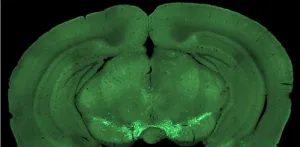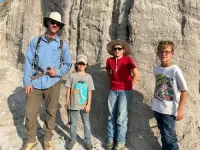New study confirms presence of benzene in natural gas and potential for undetectable indoor leaks
Findings highlight the need for stricter standards for natural gas odorization and leak detection
2024-06-04
(Press-News.org) OAKLAND, CA – New research finds that even people with an average sense of smell could be living with a natural gas leak and not know it. The peer-reviewed study, published in Environmental Research Letters, finds that small gas leaks can impact indoor air quality by introducing a number of hazardous air pollutants, including the carcinogen benzene, which researchers found in 97% of natural gas samples across North America.
“While these smaller leaks are not large enough to cause gas explosions, hard-to-smell leaks are common,” said lead author and PSE Healthy Energy Scientist Sebastian Rowland. “The fact that they are so small makes them hard to identify and fix, which can lead to a persistent indoor source of benzene and methane.”
The study is the first to assess whether gas leaks contain enough odorant to protect against elevated levels of benzene exposure, and provides the most comprehensive data to date on residential natural gas composition. Researchers from PSE Healthy Energy and Stanford University collected and analyzed 587 samples of natural gas from 481 residences through 17 North American cities. Samples were tested for methane, hazardous air pollutants, and sulfur-based odorants and researchers modeled the amount of gas that could leak undetected by a resident with an average sense of smell. Their findings confirm that benzene and other hazardous air pollutants are present in nearly all natural gas supplied to households, buildings, and businesses throughout North America.
“Our nose is the first and only line of defense against household-level gas leaks,” said PSE Senior Scientist Drew Michanowicz. “Given the variation in odorant levels and the enormous disparity in the ability to smell across the general public, our findings really call into question the sole reliance on odor to protect people from gas leaks.”
On average, gas delivered to homes in Vancouver, Los Angeles, Calgary, and Denver had twice the benzene levels than the other cities, with benzene levels in Vancouver nearly fifty times greater than that of the lowest-concentration city, Boston. Odorant levels in Houston gas were approximately five times higher than Toronto, whereas the neighboring cities of New York City and Washington, D.C., appeared to use different odorant products altogether, indicating a lack of standardization. On average, measured natural gas odorant levels should alert most occupants to gas leaks that can lead to high benzene exposures; however, each household faces a different situation due to differences in personal smelling sensitivity, ventilation rates, gas composition, and barriers to fixing leaks after detection.
The researchers suggest that regulators and consumers would benefit from greater transparency of natural gas composition, such as open access to natural gas composition data and regular sampling. Additionally, improving leak detection through stricter odorization standards or increased usage of leak detecting devices, or reducing gas use altogether can improve indoor air quality and public health.
###
About PSE Healthy Energy
PSE Healthy Energy (PSE) is a scientific research institute generating energy and climate solutions that protect public health and the environment. PSE provides expertise in public health, environmental science, and engineering and brings science to energy policy through actionable research, communications, and advising. Visit us at psehealthyenergy.org and follow us on Twitter @PhySciEng.
END
ELSE PRESS RELEASES FROM THIS DATE:
2024-06-04
The production of antibodies, essential for protecting our body against infections, is very well regulated through the action of a specific subtype of immune system cells, follicular helper lymphocytes. Now, a team led by Luís Graça, group leader at the Instituto de MedicinaMolecular João Lobo Antunes (iMM) and Professor at the Faculty of Medicine of the University of Lisbon, has dedicated itself to the detailed characterization of the functioning of these cells, in an article published today in the prestigious ...
2024-06-04
DARIEN, IL – A new study to be presented at the SLEEP 2024 annual meeting found that drowsy driving by teenagers is a common threat to public safety on U.S. roadways.
Results of the National Sleep Foundation study show that approximately one in six adolescent drivers reported having driven drowsy. Based on these responses, the authors project that 1.7 million teenage drivers have driven drowsy, and more than 400,000 teens drive drowsy at least once per week. The majority of teens pointed to work or ...
2024-06-04
DARIEN, IL – A new study to be presented at the SLEEP 2024 annual meeting is the first to find that episodic hypoxemia and hypoxic burden related to obstructive sleep apnea are associated with the risk of accelerated lung cancer reoccurrence.
Results show that a 4% oxygen desaturation index of more than 15 and time spent in desaturation events were risk factors for cancer reappearance in less than two years. Measures of hypoxic burden such as time spent below 89% oxygen saturation, average oxygen saturation value below 89%, and single nadir oxygen levels, showed a similar association. After adjustment for potential confounders, average oxygen saturation below 89% and single minimum ...
2024-06-04
DARIEN, IL – A new study to be presented at the SLEEP 2024 annual meeting found that healthy sleep has a positive impact on gratitude, resilience and flourishing in adults.
Results show that subjective sleepiness and mood disturbances improved with earlier bedtimes that extended sleep by an average of 46 minutes per night and worsened with later bedtimes that reduced nightly sleep by an average of 37 minutes. Measures of flourishing, resilience and gratitude significantly improved across the week with sleep extension and significantly worsened with sleep restriction. Sleep-extended ...
2024-06-04
DARIEN, IL – A new study to be presented at the SLEEP 2024 annual meeting offers a framework for an objective, non-invasive and zero-effort sleep monitoring system utilizing smart thermostats equipped with motion sensors.
Results show that smart thermostats identified three distinct sleep quality clusters, with clear variations in sleep duration, disturbances and efficiency. Comparative analysis underscored the heterogeneity in sleep quality, highlighting the potential of smart devices and NextGen IoT data sources in identifying sleep patterns and contributing to sleep research ...
2024-06-04
Ever wondered how your brain decides when to act? Initiating actions with a specific goal in mind is a complex process. Previous research has identified certain parts of the brain and chemical signals involved. However, it remains unclear what information these signals convey and how they spark initiative.
Recent research reported in Neurophotonics dives into this mystery by investigating how mice time their actions in pursuit of rewards, exploring the role of a specific brain pathway called the mesocortical pathway, in the context of self-initiated ...
2024-06-04
PRESS RELEASE UNDER EMBARGO UNTIL JUNE 4, 2024 at 5 a.m. US EASTERN TIME
CONTACT: Julio Poletti, Public Relations Manager, Julio.poletti@dmns.org, 917.783.6760
DENVER (May 28, 2024) — The Denver Museum of Nature & Science announces the discovery and display of a teenage Tyrannosaurus rex fossil— affectionately named “Teen Rex” — in its temporary experience, "Discovering Teen Rex" opening to the public on June 21, at 1:30 p.m. The fossil was discovered in the badlands of North Dakota by ...
2024-06-04
May 30, 2024, Leiden, The Netherlands - A 3D model of imitation blood vessels will make it possible to see exactly how snake venom attacks blood vessels, without having to use laboratory animals. This new research model, called an organ-on-a-chip, was developed by a research team from Vrije Universiteit Amsterdam, MIMETAS and Naturalis Biodiversity Center.
Roughly one hundred thousand people die annually from the effects of a snake bite and four times as many sustain chronic injuries. Research into how snake venom ...
2024-06-04
Floating solar photovoltaic panels could supply all the electricity needs of some countries, new research has shown.
The study, by researchers from Bangor and Lancaster Universities and the UK Centre for Ecology & Hydrology, aimed to calculate the global potential for deploying low-carbon floating solar arrays. The researchers calculated the daily electrical output for floating photovoltaics (FPV) on nearly 68,000 lakes and reservoirs around the world, using available climate data for each location.
The researchers’ ...
2024-06-04
Embargoed until 4 a.m. CT/5 a.m. ET Tuesday, June 4, 2024
DALLAS, June 4, 2024 — Driven by an older, more diverse population, along with a significant increase in risk factors including high blood pressure and obesity, total costs related to cardiovascular disease (CVD) conditions are likely to triple by 2050, according to projections from the American Heart Association, observing 100 years of lifesaving service as the world’s leading nonprofit organization focused on heart and brain ...
LAST 30 PRESS RELEASES:
[Press-News.org] New study confirms presence of benzene in natural gas and potential for undetectable indoor leaks
Findings highlight the need for stricter standards for natural gas odorization and leak detection







